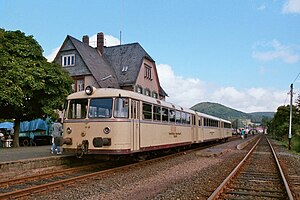HKB VT 54 / VM 56 / VS 55
| HKB VT 54 / VM 56 / VS 55 | |
|---|---|
| Numbering: | Hersfeld circular path : VT 54 / VM 56 / VS 55 |
| Number: | 1 |
| Manufacturer: | Uerdingen wagon factory |
| Year of construction (s): | 1966 and 1968 |
| Axis formula : | Bo + 2 + 2 |
| Type : | Uerdingen |
| Gauge : | 1435 mm ( standard gauge ) |
| Length over buffers: | 27,500 mm (two parts ) 40,510 mm (three parts) |
| Length: | 25,900 mm (two parts ) 39,050 mm (three parts) |
| Width: | 3000 mm |
| Fixed wheelbase: | 6000 mm |
| Total wheelbase: | 6000 mm (single carriage) 19,150 mm (two-part) 32,700 mm (three-part) |
| Service mass: | 18,900 kg (railcar) |
| Wheel set mass : | 9500 kg (railcar) |
| Installed capacity: | 2 × 110 kW (2 × 150 PS) |
| Wheel diameter: | 900 mm |
| Motor type: | Büssing AG U 10 |
| Motor type: | Underfloor motor |
| Power transmission: | mechanical with six-speed gearbox |
| Brake: |
Indirect brake type KE Magnetic rail brake, hand brake |
| Seats: | 116 (two-part) 175 (three-part) |
The railcar HKB 54 VT / VM 56 / VS 55 of Hersfelder circular path (PCL) was a three-piece railcar of DÜWAG . It was derived from the class 591 railcars made by the manufacturer for the Spanish railway company Renfe . The unit was in use until 1994 and was then used as a museum vehicle.
development
Since 1956, railcars of the series 591 were in use by the Spanish railway company Renfe , first as a prototype, then as series vehicles with the cooperation of Spanish companies. Ten years later, a similar vehicle for standard gauge was built in Germany for the Hersfeld district orbit .
The technology of the cars was derived from the DB class VT 98 . The car bodies corresponded to the Renfe wagons with end wall transitions, while the running gear with the wheelsets corresponded to the VT 98 of the Deutsche Bundesbahn.
At the beginning the railcar unit consisted of a railcar and a control car . 1968 was followed by a drive-less intermediate car, so a three-piece train set with while driving by travelers usable wagon transition was available. The unit could be adapted to changing traffic flows by removing or adding the intermediate car, which was rarely used in practice.
The two-part design was chosen because there were concerns about the incline profile at HKB. After the vehicle had proven itself in practical use, adding a non-powered intermediate car was unproblematic. The individual vehicles were numbered consecutively, the intermediate car had the highest number.
technology
The railcar VT 54 is designed similarly to a DB-VT 98, but has only one driver's cab. At the end of the transition there is a straight front wall, the car transition is protected with a bellows . The control car is constructed in the same way. The middle car received a bellows transition on both ends. All trolleys have additional space for luggage at the transition ends next to the entry doors.
The machine system was taken over from the VT 98. The large center headlight comes from the Spanish series.
The cars are connected to one another with central buffer couplings, the motor coaches and control cars have side buffers with regulating screw couplings at the driver's cab . This makes it possible to take an additional sidecar with you if necessary.
commitment
The motor power of the railcar was sufficient for the route profile of the Hersfeld circular path. The unit was used particularly in school and commuter traffic. When the volume of traffic continued to decline in the early 1980s, it handled almost all passenger traffic. The railcar unit ran until the early 1990s and was then parked with an engine failure. In the end it only ran in two parts.
At the end of 1993, the railcar was transferred to the Frankfurt-Königsteiner Eisenbahn and repaired by the local workshop. The motor power of the railcar was not sufficient for the larger gradients on the FKE , so that the unit was first handed over to the historic railway in Frankfurt at the end of 1994 . In 1995/1996 the train was taken over by a private person. The new owner brought the no longer operational unit, now designated with the numbers VT 50, VM 20 and VS 30, into the vehicle inventory of the Hochwaldbahn e.V., which is committed to maintaining and reactivating the Hunsrückquerbahn . V. a. In 2009 the train was transferred to Zittau and parked there.
literature
- Markus Schmitt, Michael Knauf: Die Hersfelder Kreisbahn , EK-Verlag, Freiburg 2001, ISBN 3-88255-445-2
Web links
Individual evidence
- ↑ a b Markus Schmitt, Michael Knauf: Die Hersfelder Kreisbahn , EK-Verlag, Freiburg 2001, page 144, ISBN 3-88255-445-2
- ↑ a b Markus Schmitt, Michael Knauf: Die Hersfelder Kreisbahn , EK-Verlag, Freiburg 2001, page 82, ISBN 3-88255-445-2
- ↑ VT 50 (iA); Special design Uerdinger rail bus with interchange. HWB Hochwaldbahn-Verbund, June 2004, accessed on January 25, 2020 .
- ↑ Transfer and everyday life in the Nahe ... (11B.). April 19, 2009, accessed on January 25, 2020 (photos of the transfer to Zittau).


